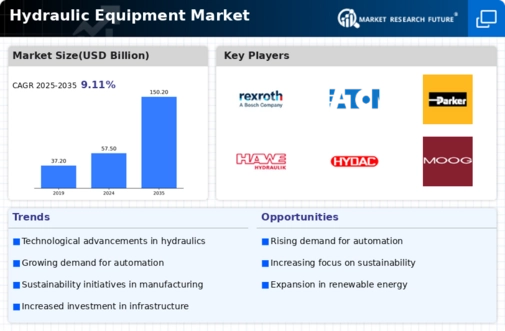Hydraulic Equipment Size
Hydraulic Equipment Market Growth Projections and Opportunities
The Hydraulic Equipment Market is influenced by a multitude of factors that collectively shape its growth and trajectory. One of the primary drivers is the widespread application of hydraulic systems across various industries, ranging from construction and agriculture to aerospace and manufacturing. Hydraulic equipment, powered by fluids, provides reliable and efficient solutions for tasks such as lifting, pressing, and conveying heavy loads. The versatility and high power density of hydraulic systems contribute to their continued demand in diverse industrial sectors, driving the growth of the hydraulic equipment market.
Technology improvements are important reasons for changes in the Hydraulic Equipment Market. Hydraulic parts like pumps, engines and valves are always getting better. This makes our hydraulics systems work well with less problems. Adding smart things like sensors and control systems to hydraulic tools makes them more accurate and can do tasks by themselves. As companies try to make things work better and cut down on breaks, they need more modern ways of using hydraulics. This is making their industry grow faster.
The Hydraulic Equipment Market is greatly affected by international economic situations and manufacturing activities. Growth in the economy, building up of roads and bridges (infrastructure), more factories make people need hydraulic tools. This is for jobs found in construction work, mining activities and making things (manufacturing). On the other hand, times of economic slowdown might lead to less spending on business growth. This can hurt how well markets do. Big businesses that need hydraulic systems, like construction and farming, depend on money matters. This affects the wider market movements too.
Rules made by the government and concerns about nature are very important in forming the Hydraulic Equipment Market. Rules about pollution, saving energy and safe workplaces change the way hydraulic tools are made. The business is really interested in making hydraulic systems that use less energy and cause less harm to nature. Following these rules makes makers spend money on greener and long-lasting water machines.
Competition in the market and important companies are key elements for Hydraulic Equipment Market. Hydraulic machine makers and suppliers create a contest. This leads to constant changes in how hydraulics work, always making them better. Working together, joining forces and merging companies in the industrial field help grow and change hydraulic equipment solutions. This affects how markets move forward or slow down.
Development of infrastructure is a main reason for the growth in Hydraulic Equipment Market. As countries spend money to create and improve their buildings, they have a long-lasting need for water machines in building projects, transport networks and power creation. Hydraulic systems are very important for big machines used to dig, lift and move things. They play a key role in building roads, bridges and other structures.
Electric and hybrid cars becoming more popular change the Hydraulic Equipment Market. Hydraulic systems have usually been used in big machines and factories. But now, there's a lot of interest in making small and good working hydraulic options for electric or hybrid cars that save energy too. The need for green and power-saving hydraulic gear in the car industry gives new chances and problems to those who sell these products. Customer demands for energy efficiency and cost-effectiveness influence the Hydraulic Equipment Market. End-users seek hydraulic systems that offer high performance while minimizing energy consumption and operational costs. Manufacturers are responding to these demands by developing energy-efficient components and systems, incorporating innovative materials, and optimizing the overall design to enhance the competitiveness of hydraulic equipment in the market.
















Leave a Comment